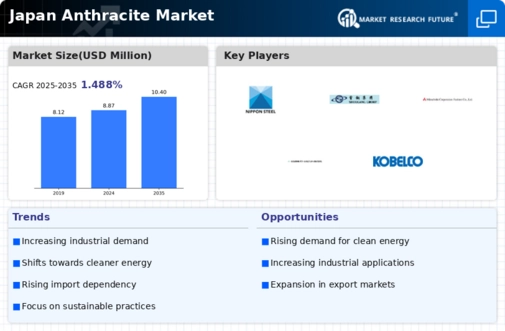The Japan Anthracite Market is characterized by a dynamic competitive landscape that is shaped by a variety of factors, including demand for energy, advancements in production technologies, and fluctuations in global coal prices. Anthracite coal, known for its high carbon content and low impurities, plays a crucial role in various industrial applications, particularly in the metallurgy and steel-making sectors. As the demand for cleaner energy sources increases, the market is witnessing a shift towards the more efficient use of anthracite to reduce emissions.
The players in this market are consistently innovating their processes and strategies to maintain a competitive edge while also addressing environmental concerns. Nippon Steel Corporation holds a prominent position in the Japan Anthracite Market, leveraging its extensive experience in steel manufacturing and metallurgical processes. The strengths of Nippon Steel Corporation lie in its advanced production capabilities, which are complemented by a robust supply chain that ensures consistent quality and availability of anthracite coal for its operations. This strategic advantage enables the company to optimize its steel production processes while maintaining compliance with stringent environmental regulations.
The company has invested heavily in research and development, focusing on improving the efficiency of anthracite use and developing technologies that further minimize the environmental impact. Furthermore, its established relationships with local and international suppliers bolster its market presence within Japan, allowing for continued growth and stability.Shougang Group, while primarily recognized for its vast portfolio in the steel manufacturing sector, also plays a significant role in the Japan Anthracite Market. The company specializes in providing high-quality anthracite products essential for metallurgical applications, enhancing its role as a key supplier in the region.
Shougang Group's strength lies in its ability to combine traditional manufacturing practices with modern technological advancements to improve the quality and sustainability of its products. The company has also engaged in strategic partnerships and collaborations that contribute to its market presence. These efforts have solidified Shougang Group's reputation in Japan, making it a reliable player in the anthracite space. Its approach to mergers and acquisitions is strategic, focusing on acquiring assets that complement its existing operations and enhance its capacity to supply anthracite coal effectively.
This ongoing commitment to growth and innovation positions Shougang Group favorably within the competitive landscape of the Japan Anthracite Market.
















Leave a Comment